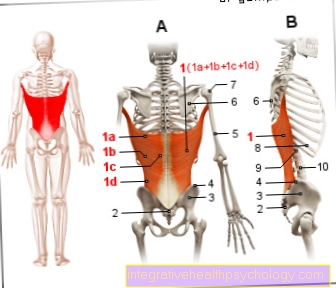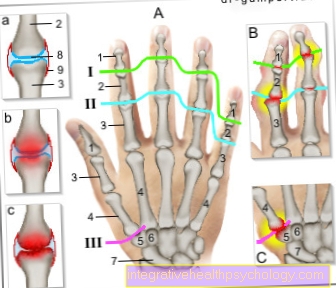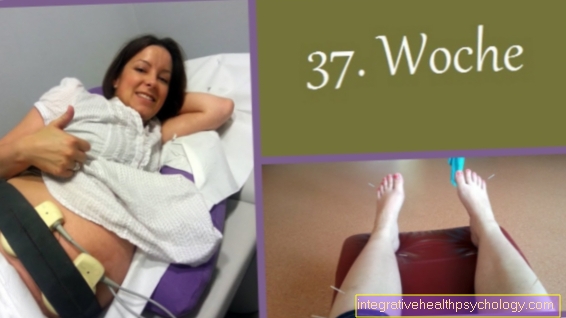Brachial plexus paralysis
introduction
As Brachial plexus one designates a network of several annoythat in the neck area from the Spinal cord exit and serve to innervate the muscles of the shoulder and arm area.
The nerves form a complex interwoven cord that runs between Collarbone and first rib pulls towards the arm on both sides. In the area of this narrow point, various causes can easily lead to an injury to the nerve plexus different neurological failures can result, depending on which nerves are particularly damaged.
Such injuries can also lead to a complete failure of the brachial plexus, which is then called complete brachial plexus paralysis referred to as.
causes

The causes of brachial plexus paralysis are varied.
Accidents, such as traffic accidents with a motorcycle or falls from a great height, are a common cause. The impact can pinch the nerves between the collarbone and the first rib; at the same time, the nerves are strongly stretched when the head is overstretched.
The nerves cannot withstand this sudden load and tear.
Brachial plexus paralysis can also occur during childbirth if the midwife pulls on the child's head. Here, too, the head is overstretched and there are strong tensile forces on the brachial plexus. The nerves can then also tear.
Furthermore, paralysis of the brachial plexus can also occur as a complication of an operation. This often involves so-called positional damage when the patient's arm is in an unfavorable position during a long operation and pressure is exerted on the nerve plexus.
Ultimately, any kind of inflammation can impair the functioning of the nerves. Malignant diseases that develop near the arm, such as breast cancer (Breast cancer) or bone tumors in advanced stages can spread to surrounding structures and also grow into the brachial plexus. The result is also paralysis of the nerve plexus.
Furthermore, the nerve plexus of the arm can be temporarily anesthetized if the stellate ganglion is blocked. Affected people can temporarily make it difficult to move the arm / hand. Read more about this under: Stellate ganglion blockage
Symptoms
The brachial plexus paralysis can develop, depending on which nerves are particularly damaged different symptoms manifest.
In different places on the affected arm Sensory disturbances, Signs of paralysis and or Pain occur. Especially when nerve roots are in the Spinal cord area tear away, pain often occurs.
These are sharp, burning and dragging down to the affected arm or hand.
If the nerves are damaged, those supplied by it suffer Muscles a loss of function, which can lead to paralysis of the various muscle groups in the arm and hand.
If only the lower part of the brachial plexus is damaged, is a paralysis of the Hand muscles typical. This form of paralysis is also called Klumpke's palsy designated. Patients can often no longer move their wrist. In the long term, the lack of muscle innervation leads to a muscular dystrophy (Muscular atrophy). The corresponding arm then becomes clear thinnerbecause the inactive Musculature is broken down by the body. Sensory disturbances occur most frequently in the case of paralysis of the brachial plexus Outside of the upper and lower arm. However, they are not found in every patient.
When a newborn is affected by paralysis of the brachial plexus due to birth complications, this often manifests itself in the fact that it no movements in the shoulder joint executes. This often goes away by itself over time, but there is also some risk in the long term Stunted growth of the affected arm.
diagnosis
In order to determine a lesion of the brachial plexus, the doctor will first look at the one that has occurred Injury Mechanism explain.
This already gives the first indications that the plexus may have been damaged.
The patient's clinical symptoms reported by the doctor during a physical exam raises, give further clues. Imaging procedures, like that Computed Tomography (CT) and the Magnetic resonance imaging of the shoulder (MRI of the shoulder) put bone and soft tissues of the patient so that injuries can be identified directly.
As part of a Myelography can do that too Spinal cord can be displayed directly. Nerve tears or tears of individual nerves can thus possibly be recognized directly.
therapy
In the therapy of the brachial plexus paralysis is usually first a complete relief of the affected arm tried.
In many cases, the symptoms improve because the annoy Get time to regenerate. Stretching or other manipulation of the damaged nerve plexus must be avoided at all costs. Healing a plexus lesion is often a lengthy process.
Brings the exonerating procedure after no later than one half year no improvement, an operation has to be considered. In some cases, the operation is done earlier. Torn nerves can do this sewn In the case of long demolitions it may also be necessary to install a Nerve transplant to undertake. These operations are very difficult and require a lot of experience from the surgeon. To a complete regression the symptoms often do not occur even after surgical measures.
physical therapy
Targeted physiotherapy exercises are very important in the treatment of brachial plexus paralysis.
They serve the function of now less activated Musculature to maintain and promote and thus prevent the breakdown of the muscles. Also Shortening of the muscles (Contractures) should be prevented by the exercises. Since the one-sided regression of the muscles can also lead to uncomfortable bad posture, which in turn can also lead to consequential damage, is a focus of the physical therapy also on maintaining the symmetry of the body.
Do the exercises often several times a day also at home carried out by the patient in order to achieve optimal activation of the muscles.
For children who are affected by plexus paralysis immediately after birth, there are special, very intensive ones Therapy procedure (for example after Vojta and Bobath), which require a lot of discipline from parents and children. However, if the therapy concept is adhered to, this often shows very good result.
forecast
The prognosis of paralysis of the brachial plexus is very different, depending on the extent of the damage. Generally, healing takes time annoy very long.
In the case of severe injuries, that too surgical intervention In many cases, not all complaints resolve completely. Overall, there is always a certain permanent risk neurological failure symptoms.
prophylaxis
Most of the paralysis of the brachial plexus arises accident-related.
Prudent behavior in the Road traffic and in dangerous situations is therefore a prerequisite to avoid such injuries.
In operations it is proper storage of the patient is essential in order to prevent pressure damage to the plexus. An optimal training of Obstetricians reduces the risk of plexus lesions in newborns, but despite great caution on the part of the staff, plexus paralysis can theoretically occur.
Inherited paralysis
In the case of paralysis of the brachial plexus can two forms be distinguished - the so-called Inherited paralysis as well as the Klumpke's palsy.
While at the Klumpke's palsy of the lower part of the brachial plexus is affected Inherited paralysis of the upper part the nerve plexus damaged.
In hereditary paralysis, therefore, are the Spinal cord segments C5 and C6 affected. As a result, the Shoulder and upper arm muscles in their function. Of the Elbow however, it can still be stretched.
In Klumpke's palsy, that's Extension in the elbow not possible anymore. They are damaged Spinal cord segments C7 to Th1causing failure of the Forearm and hand muscles leads.





























